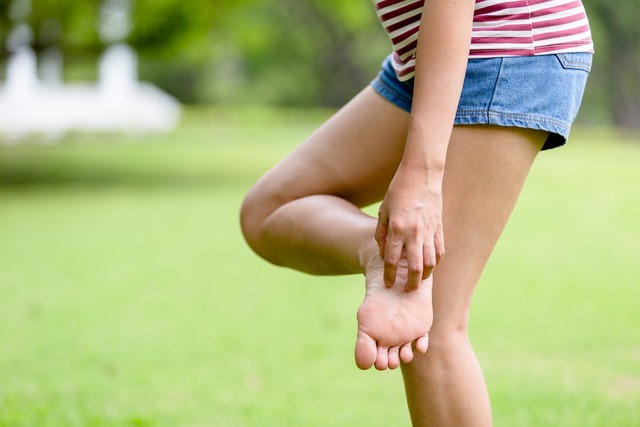Health
Itchy Feet: 10 Main causes and what to do
Published
3 years agoon
By
Olu Emmanuel
In most cases, itchy feet are caused by dryness of the skin, especially during winter. However, another very common cause is fungal overgrowth, also known as ringworm, which can be treated with antifungal ointments advised by a family doctor or dermatologist.
Itchy feet can also be caused by less common problems such as allergy, psoriasis or poor circulation, for example, and other symptoms can appear that help to identify the problem and define the most appropriate treatment, which will depend on what caused it. of the itch.
1. Dry skin
The skin on the foot can become dry easily because there are no sebaceous glands in this region and people tend to neglect hydration in this area. This dryness can cause intense and persistent itching if left untreated.
What to do: The treatment of dry skin is simple and consists of applying moisturizing creams on your feet daily after bathing. The ideal is to opt for very nutritious creams with urea or salicylic acid in their constitution that help to remove dead skin.
2. Peripheral neuropathy
Peripheral neuropathy is a set of changes that occur in the body’s nerves, causing symptoms such as pain, tingling, lack of strength, sensitivity in specific regions of the body and itching. This disease is usually caused by diabetes mellitus, leprosy, severe malnutrition or autoimmune diseases.
What to do: The treatment is done according to the needs of each person. Pain relievers such as dipyrone and acetaminophen, and medications to help with sexual dysfunction such as sildenafil or tadalafil may be prescribed. In addition, physical therapy can also be used to rehabilitate the affected areas.
3. Psoriasis
Psoriasis is a skin disease that causes symptoms such as red spots, dry scales, dry skin, itching and pain.
What to do: Psoriasis is not curable, but it can be treated with skin creams and ointments, immunosuppressive and anti-inflammatory drugs, and treatments with ultraviolet light may also be recommended.
4. Athlete’s foot
Athlete’s foot, also known as tinea pedis or chilblain, is a type of skin ringworm caused by the fungi Trichophyton, Mycrosporon or Epidermophyton, which mainly affects regions on the sole and between the toes, causing intense itching and scaling.
What to do: The treatment consists of applying antifungal creams or ointments, such as clotrimazole or miconazole. If this is not enough, it may be necessary to take itraconazole or fluconazole tablets for about 3 months. It is also necessary to take care with the hygiene of the feet and avoid humidity, as it can worsen the condition and prolong the treatment.
5. Foot bug
Peanuts are a small parasite called Tunga penetrans, which enters the skin, especially the feet, where it develops quickly causing symptoms such as pain, itching and redness.
What to do: To treat this infection, the skin parasite has to be removed at a health clinic. In addition, creams based on camphor or salicylated Vaseline can be used in order to facilitate the treatment, or if there are many lesions, antiparasitic use is recommended, such as thiabendazole or ivermectin.
6. Hand-foot-mouth syndrome
The hand-foot-mouth syndrome is a very contagious disease caused by the virus, causing symptoms such as high fever, sore throat, lack of appetite, appearance of canker sores and small blisters or spots on the hands and feet, which can cause intense itching.
What to do: The treatment consists of administering medicines for fever and anti-inflammatories for pain, medicines for itching and ointments for thrush to alleviate the symptoms.
7. Allergy
Skin allergy is characterized by an inflammatory reaction that can manifest itself in different regions of the skin, which can be caused by food, cosmetics, medicines, sun or insect bites, for example, and cause symptoms such as itching, redness, peeling , irritation and presence of reddish or white spots or balls.
What to do: Usually the treatment is with antihistamines such as loratadine or cetirizine, or with corticoids such as betamethasone, which are used to treat the symptoms of the allergy, and stop the use of the cause of the allergy.
8. Poor circulation
Poor circulation is the difficulty for blood to pass through the veins, causing symptoms such as cold hands, swelling in the feet, tingling and itchy sensations in the feet and legs, and pain in the legs with the appearance of varicose veins.
This problem is more common in women and can become more intense during pregnancy and cause severe swelling in the feet.
What to do: To improve blood circulation, you should exercise frequently, wear elastic compression stockings, avoid sitting or standing for too long, reduce salt intake and maintain an ideal weight.
9. Dyshidrosis
Dyshidrosis causes the appearance of small blisters filled with clear fluid on the palms of the hands or soles of the feet, especially on the sides of the toes, which cause intense itching, which can last up to 3 weeks.
It is more common in summer, with rising temperatures, or episodes of emotional stress, and although it is not known for sure what causes it, it is thought to be associated with atopic dermatitis and contact dermatitis.
What to do: to treat dyshidrosis, the dermatologist may advise the application of corticoid creams such as clobetasol or methylprednisolone for example, or the use of corticoid tablets when creams and ointments do not show results or in very extensive cases.
10. Larva Migrans
Cutaneous larva migrans, also known as geographic bug, is caused by a parasite that can be found in soil contaminated by dog or cat feces and penetrate the skin, through small wounds, causing a lot of itching and a reddish and serpiginous lesion at the site of input, mainly feet, legs and hands.
What to do: The treatment for cutaneous larva migrans is done with the use of antiparasitic medicines, such as Tiabendazole cream for small lesions, or oral Albendazol or Mebendazole, in the case of many lesions.
Trending

 Football7 days ago
Football7 days agoGuardiola advised to take further action against De Bruyne and Haaland after both players ‘abandoned’ crucial game

 Health & Fitness1 day ago
Health & Fitness1 day agoMalaria Vaccines in Africa: Pastor Chris Oyakhilome and the BBC Attack

 Featured5 days ago
Featured5 days agoPolice reportedly detain Yahaya Bello’s ADC, other security details

 Education6 days ago
Education6 days agoEducation Commissioner monitors ongoing 2024 JAMB UTME in Oyo

 Comments and Issues7 days ago
Comments and Issues7 days agoNigeria’s Dropping Oil Production and the Return of Subsidy

 Business6 days ago
Business6 days agoMaida, university dons hail Ibietan’s book on cyber politics

 Education1 week ago
Education1 week agoOsun NSCDC solicits cooperation towards national assets protection

 Crime6 days ago
Crime6 days agoPolice take over APC secretariat in Benue

